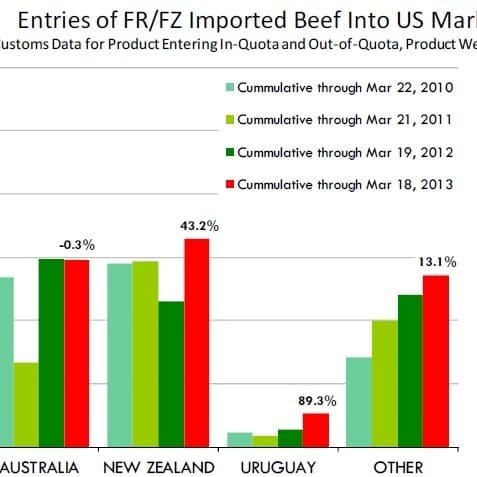
THE extent of drought conditions across large parts of New Zealand is reflected in first quarter export statistics which show that perhaps for the first time in history, NZ exceeded Australia in tonnage of manufacturing beef shipped to the United States.
Beef Central wrote about the New Zealand drought in this earlier article.
According to US Customs data through to March 18, US imports of fresh/frozen beef are currently around 2.6 percent above year-ago levels.
“While the overall import picture is not much different than a year ago, the dynamics of imports from various countries is dramatically different,” analyst Len Steiner said in a recent Daily Livestock Report.
One supplier that has substantially increased its beef exports to the US in the last couple of months has been New Zealand, with entries up 43pc for the first quarter, from a year ago.
For the first time, NZ is the largest beef exporter importer to the US in the first quarter of 2013.
NZ over the years has significantly increased the size of its dairy industry, and is currently the largest global exporter of dairy products. The industry’s growth has also delivered a steady supply of manufacturing beef, in for form of dairy steer and cull cows. Since 2000, the dairy herd in NZ has increased from 3.3 million to 4.8m dairy cows – a 45pc increase.
Total human population in NZ is 4.4 million people, meaning export is a critical part of the country’s beef turnoff, especially for manufacturing meat.
Since the beginning of the year, NZ has experienced one of its worst droughts in more than thirty years, leading to water shortages and parched pastures. The drought has been especially extreme in the North Island, where about two thirds of the nation’s dairy herd is located.
In February and the first two weeks of March, total cattle slaughter in NZ has averaged 52pc above year ago levels, and this is before the normal cull season begins in late April and May, Daily Livestock Report said.
“New Zealand farmers are hoping that the dry spell will be broken soon but with each passing day of bright blue skies, the situation could get more dire and force a significant liquidation of the dairy herd,” DLR said.
Chicago Mercantile Exchange’s milk futures have rallied on the deteriorating NZ conditions, with the June contract closing at a little over US19c/lb, compared to US17.5c in early March.
The increase in NZ cow slaughter will likely push more beef to the US in April and May, Mr Steiner suggested.
Looking at other significant beef suppliers to the US, beef imports from Canada were down 29pc for the first quarter, from a year ago.
Much of the beef imported from Canada was from steers and heifers fed on feedlots in Alberta and Saskatchewan. Lower feedlot inventories in Canada, a strong Canadian dollar and an increase in feeder cattle shipments to the US had limited that amount of boxed beef coming to the US from north of the border during Q1.
Beef imports to the US from Australia are on even terms with a year ago, even as Australian cattle slaughter has increased sharply in recent weeks. Weekly cattle slaughter in Australia in February and mid-March has averaged about 15.5pc above year-ago levels, but so far this has not translated into a big increase in exports to the US market.
“Indeed, our forecast is that Australian March exports to the US will likely be about 30pc smaller than they were a year ago,” the Daily Livestock Report said.
The US no longer is the ‘favoured destination’ for Australian packers and shipments to the US account for 20pc or less of overall Australian shipments.
More recently, China has emerged as a major destination for Australian beef. Beef prices in China have increased sharply in the last 18 months and Chinese buyers have become increasingly active in a number of markets.
In February, China was the third largest market for Australian beef, and it also bought about twice as much beef from Uruguay as Russia did.
Australian shipments to the US this year will depend greatly on what other markets are willing to pay, and so far China has been quite willing to clean-up the additional supply, Mr Steiner said.
China is on track to take about 50,000t of Australian beef in the 2012-13 fiscal year.
US feedlot placements lower than expected
Meanwhile USDA’s monthly Cattle-on-Feed report, released last Friday, showed lower placements than what the market was expecting.
February placements into feedlots with capacities of +1000 head numbered 1.482 million head, 13.5pc down from year-ago figures and nearly 78,000 less than what was expected, on average, by analysts.
The total March 1 feedlot inventory of 10.857m head, however, represents the largest year-on-year decline yet seen in the current downturn cycle that began back in September. The inventory was almost the smallest March 1 inventory of the past six years, exceeded only by the the 2010 inventory of 10.85m head.
Futures prices reacted sharply higher in the CME in the first hours of trade on Monday, but low near term beef demand made quotations go down through mid-week.
The average weight of US cattle placed in February was 714lb, almost 9lb or 1.3pc lower than a year ago.
In contrast, USDA’s monthly Cold Storage report, also released last Friday, showed continued large stocks of frozen meat as of the end of February. Total meat and poultry in freezers on February 28 was around one million tonnes, 5.7pc higher than last year, as flat consumer demand continued.
